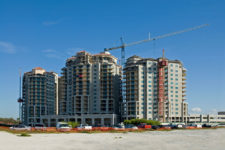The Department of Buildings released their proposed, revised penalty schedule, increasing a number of penalties for Class 1, 2, and 3 violations.
While the penalties aren’t final (yet), here are highlights of the proposed doc, plus some reminders about how DOB-ECB penalties operate in general:
1. Curing Violations
The best way to avoid penalties entirely is by curing a DOB-ECB violation, whenever applicable. If offered, a cure date will be listed on the copy of the violation. All Class 3 violations are eligible for cure dates, along with some Class 2 violations. Class 1 violations are never eligible for a cure date.
All eligible violations are noted in the proposed penalty sheet. That said, any violations marked as “Aggravated II” will never be eligible for cures, even if the column in the penalty sheet says yes. The cure date itself is typically 40 days from the violation issue date. If a Certificate of Correction is submitted to the department before that date (and the DOB accepts the same), the named respondent will have zero penalties and won’t have to appear at the scheduled hearing. Know that submitting a Certificate of Correction as a cure constitutes an admission of the violation – this means that any subsequent violations for the same issue may be subject to additional penalties (and may not be eligible for a cure date).
As a reminder, all DOB-ECB violations require a Certificate of Correction (AEU-2 form), even if you’re unable to cure the violation. Submitting a Certificate of Correction will ensure that the violation is fully closed, and in the case of Class 1 violations, prevent additional penalties to the building owner.
2. Stipulations
Like cures, violations eligible for Stipulations will be marked on the penalty sheet. If the city and the named respondent choose to enter into a Stipulation, respondents admit to the violation and file a Certificate of Correction with the Department. The Stipulated penalty charged is half the fine of what otherwise would’ve been imposed. If a Certificate of Correction isn’t filed within 75 days of the pre-hearing or hearing Stipulation date, the full penalty for that infraction will be imposed. As with eligible cure dates, no Stipulations will be offered for Aggravated II penalties.
3. Mitigations
If the respondent can prove the violation was corrected prior to the hearing date, they may be eligible for a mitigated penalty. Same as both of the above, all violations eligible for mitigation will be marked in the table (and yup – you guessed it – not including any violations listed as Aggravated II).
Aggravated penalties may (a proposed change from shall) be imposed in the NOV directly, or provided to the respondent before the first scheduled hearing date. Aggravated I penalties may be imposed when evidence establishes that the same condition or charge under the NYC Construction Codes, or the predecessor charge under the laws in effect before July 1, 2008, was in a prior enforcement action against the same owner or responsible party during the previous three years. Basically, if the named respondent garners a second or subsequent violation for the same infraction within 3 years from the last issue date, an Aggravated I penalty may be assessed.
On the other hand, Aggravated II penalties may be imposed in the following cases:
- When the violation of law is accompanied by or results in an accident, or poses a substantial risk thereof; is accompanied by or results in a fatality or serious injury, or poses a substantial risk thereof; or where the violating condition affects a significant number of people; or
- Where the respondent or defendant refuses to give the Department requested information necessary to determine the condition of a building or site; or
- Where the respondent has a history of non-compliance with DOB rules at one or more locations (including but not limited to patterns of unreasonable delays in correcting violations, failing to obey Stop Work Orders, filing false documents, or multiple defaults)
“In Violation” for Aggravated penalties means adjudged following a hearing, admitting the charge, or signing a stipulation agreement before the hearing. Failing to appear at a hearing (default) must also be deemed a finding in violation.
Certain continuing and uncorrected Class 1 violations may see additional daily penalties, while Class 2 violations may see monthly penalties. If the DOB seeks to impose daily or monthly penalties, it’ll be noted on the NOV copy. If imposed, these are in addition to any penalties assessed as part of the ECB hearing process.
Daily penalties will accrue at the rate of $1,000 per day for 45 days running from the violation issue date, while monthly penalties accrue at the rate of $250/month for a total of one month running from the violation issue date. In the case of daily penalties, proving correction will stop accrual of the penalties up to the date of proved correction.
Quite a bit, actually – a number of violations in this proposed rule will see increases, some as many as double the former penalty. For example, a number of Aggravated I default penalties are jumping to $25,000, matching totals for some Aggravated II maximum penalties. There are also some brand new infractions, mainly for Class 1 and 2 cranes and derricks and other construction-related equipment.
One standout Class 1 infraction (28-304.1 – failure to maintain elevator or conveying system) will see a significant jump for the standard penalty – the former $1,000 fine may now be $12,500.
On the other hand, a few fine amounts are actually going down. Class 1 infractions for failing to install luminous egress/photo-luminescent exit path markings in a high rise building is one of the standouts. While maximum amounts remain the same, first timers and Aggravated I offenders will see a nearly 50% decrease in fine totals.
These changes aren’t final just yet. The DOB will hold a hearing for the proposed changes on January 16th, 2018 at 10 AM (125 Worth Street – 2nd Floor Auditorium). In the meantime, you can comment on the proposed rules here or send your comments via email: dobrules@buildings.nyc.gov // or regular mail: New York City Department of Buildings, Office of the General Counsel, 280 Broadway, 7th Floor, New York, NY 10007.
We’ll let you know the final state of the rules post-hearing – stay tuned for updates!




